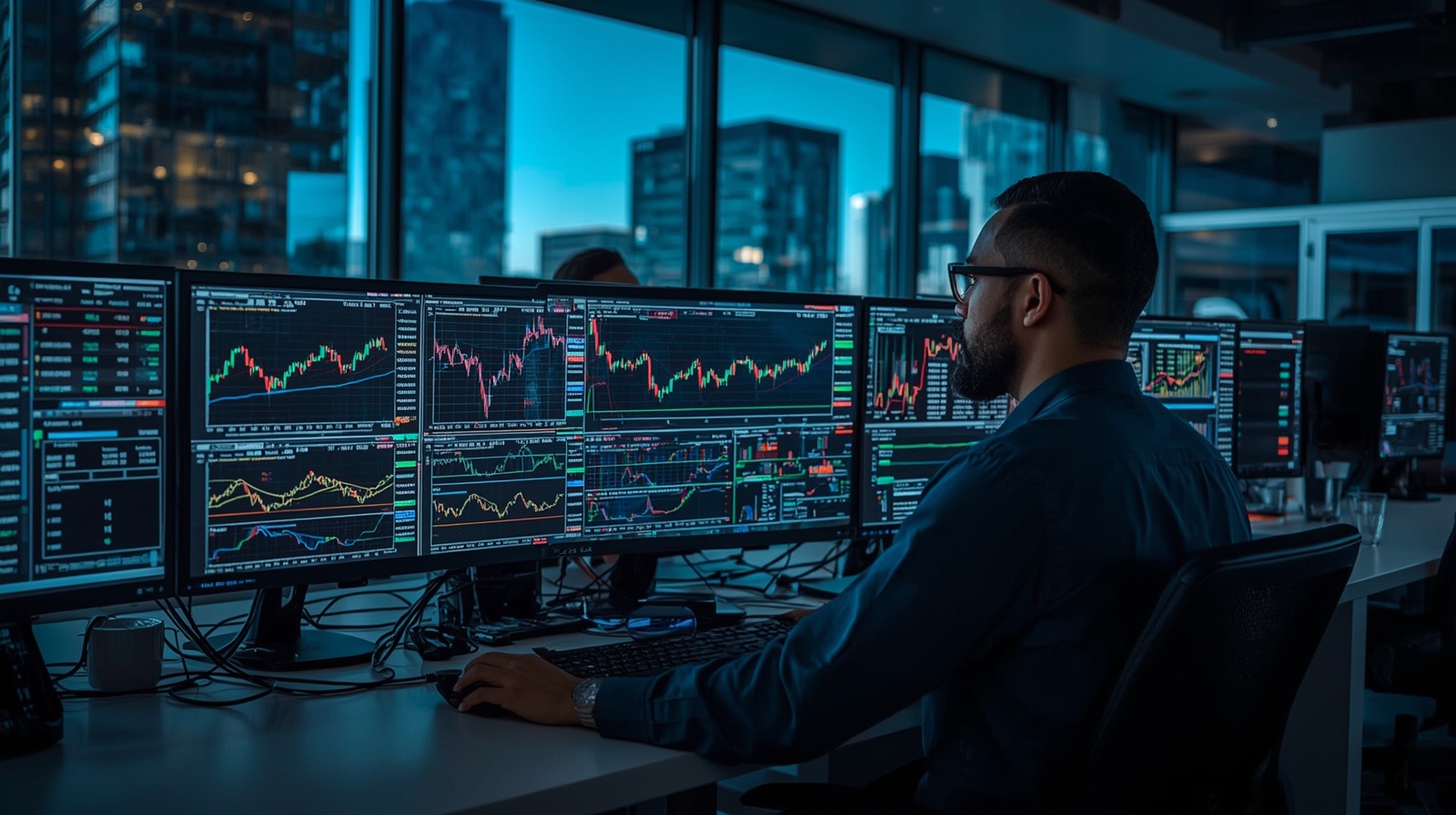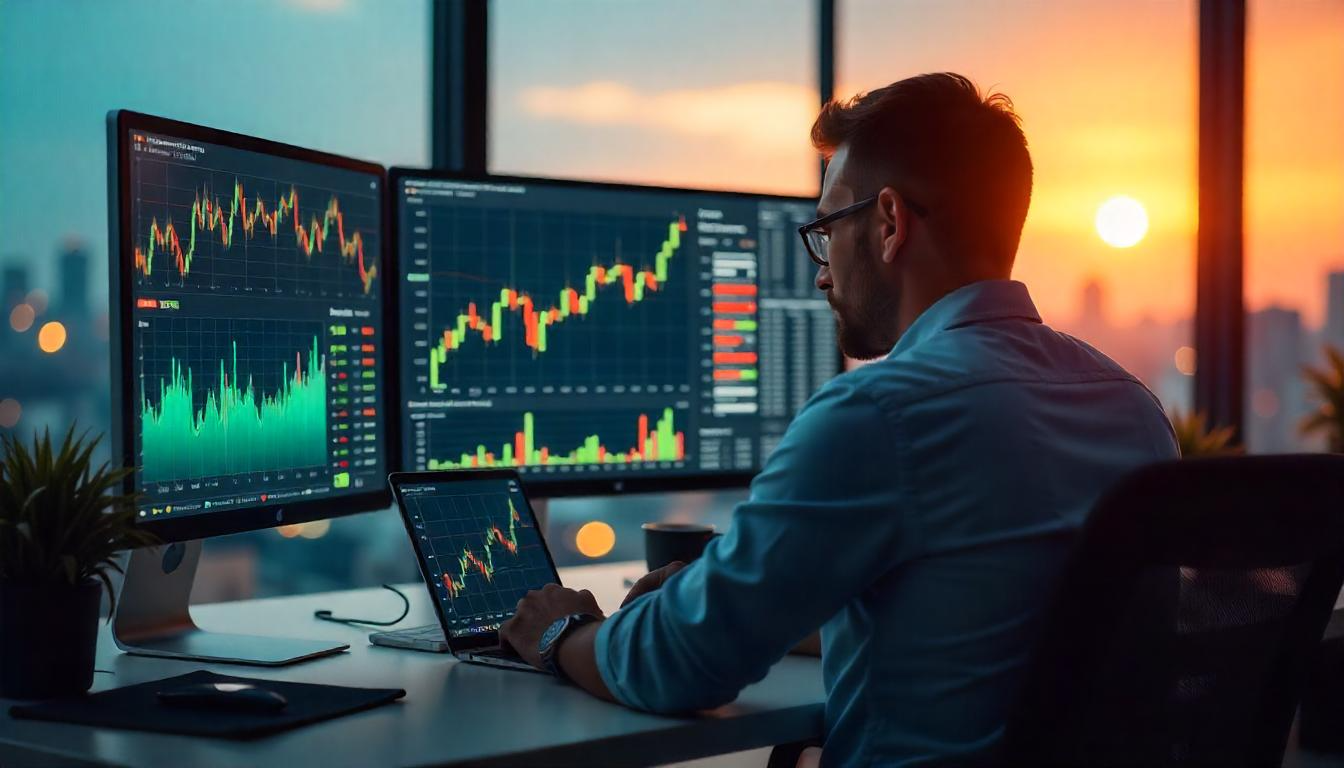Comprehensive Introduction to Modern Trading
Trading in financial markets represents a fundamental economic activity that has evolved over centuries to become one of the most important drivers of the global economy today. Trading at its core is the process of buying and selling financial assets with the aim of benefiting from price fluctuations to achieve profit, which distinguishes it from traditional investment that focuses on long-term growth.
The digital age has brought about a real revolution in the trading world, where electronic platforms and mobile applications have become indispensable tools for traders. This technological development has made access to global markets easier than ever before, allowing traders to access stock markets, forex, and even volatile cryptocurrency markets from anywhere and at any time.
Trading Evolution in the Modern Era
The year 2025 has witnessed important developments in trading, with the integration of artificial intelligence and cloud computing technologies to improve trader experience and increase prediction accuracy. Modern platforms now offer:
- Advanced AI analytics to identify investment opportunities
- Lightning-fast trade execution with automated trading systems
- Intuitive user interfaces suitable for beginners and professionals
- Advanced risk management tools to protect capital
Main Trading Types and Strategies
Day Trading: Quick Returns Strategy
Day trading is considered one of the most popular and exciting trading methods, where it involves opening and closing trading positions on the same day. Day traders seek to benefit from daily price fluctuations of financial assets to achieve quick and recurring profits.
This strategy relies on precise technical analysis and using specialized tools such as Japanese candlesticks and technical indicators. This type of trading requires:
- High concentration and continuous monitoring of market movements
- Speed in decision-making and execution
- Strict risk management due to the nature of short-term trades
- Sufficient capital to cover daily fluctuations
Swing Trading: Balance Between Speed and Stability
Swing trading represents the middle ground between day trading and position trading, aiming to achieve gains from price movements over days to weeks. This approach gives traders sufficient time to make thoughtful decisions without the speed pressure required in day trading.
Swing traders use specialized technical indicators such as:
- Stochastic indicator to identify overbought and oversold levels
- MACD indicator to monitor momentum changes
- Relative Strength Index (RSI) to assess trend strength
- Bollinger Bands to measure volatility and price ranges
Position Trading: Long-term Investment
Position trading resembles a marathon runner's journey, where traders hold securities for several months to years. This strategy is suitable for patient investors who focus on long-term trends and fundamental asset value.
Available Trading Markets and Investment Opportunities
Forex Market: Currency Trading World
The forex market is considered the largest financial market in the world in terms of daily trading volume, where trillions of dollars are traded daily. The forex market operates 24 hours a day, five days a week, providing great flexibility for traders worldwide.
The most popular currency pairs for trading in 2025 include:
| Currency Pair | Characteristics | Best Trading Times |
| EUR/USD | High liquidity, tight spreads | 13:00-16:00 GMT |
| GBP/USD | High volatility, large profit opportunities | 12:00-17:00 GMT |
| USD/JPY | Linked to bond yields, suitable for beginners | 24/5 due to Asian market nature |
| USD/CHF | Safe haven, resistant to geopolitical volatility | 08:00-17:00 GMT |
Stock Trading: Investing in Companies
Stock trading is considered one of the most popular types of trading, where company shares listed on global exchanges are bought and sold. Trader success in this field depends on monitoring company performance and analyzing financial data and management decisions.
Factors affecting stock prices include:
- Company financial performance and quarterly earnings
- Major economic events and monetary policies
- Industry news and technological developments
- Investor sentiment and general market trends
Cryptocurrency Trading: The New Financial Revolution
Cryptocurrencies have witnessed tremendous growth and become an important part of traders' portfolios. Cryptocurrency trading is characterized by high volatility and significant profit potential, but it also carries elevated risks.
In 2025, cryptocurrencies have become more stable and adopted by major financial institutions, opening new horizons for both professional and beginner traders
Choosing the Right Trading Platform
Criteria for Selecting the Optimal Platform
Choosing the appropriate trading platform is a crucial step in the success journey. The ideal platform should combine security, ease of use, and efficiency, while providing all necessary tools for analysis and execution.
Key factors for platform selection include:
- Licenses and legal regulation: Ensuring the platform holds licenses from recognized regulatory bodies
- Liquidity and spreads: Ensuring adequate liquidity and competitive price differences
- Analysis tools: Availability of advanced technical indicators and charting tools
- Customer service: 24/7 technical support in multiple languages
- Deposit and withdrawal methods: Variety of payment methods and processing speed
Best Trading Platforms in 2025
Based on trader and expert evaluations, several platforms stand out as the best available options:
- eToro Platform: Distinguished by social trading and copy trading capabilities
- Admiral Markets: Offers advanced analysis tools and a wide range of assets
- HYCM: Provides comprehensive education and support for beginners
- Interactive Brokers: Suitable for professional traders with low commissions
Advanced Trading Strategies
Trading Using Technical Analysis
Technical analysis is considered the backbone of most successful trading strategies. This approach relies on studying charts and historical price patterns to predict future movements.
Key technical analysis tools include:
- Japanese candlesticks: Patterns like hammer, shooting star, and harami
- Support and resistance lines: To determine entry and exit points
- Moving averages: To determine general market direction
- Momentum indicators: Such as RSI and MACD to measure movement strength
Trend Trading Strategy
Trend trading strategy is considered one of the most effective strategies for intermediate traders. The goal is to identify the general market direction and trade in the same direction to maximize success opportunities.
Basic trend strategy rules:
- Identify the main trend: Using long-term moving averages
- Wait for pullbacks: To enter at better prices
- Use trailing stop loss: To protect profits
- Set realistic targets: Based on support and resistance levels
Range Trading Strategy
This strategy relies on identifying a price range in which the market moves, where buying occurs at support levels and selling at resistance levels. This approach is very effective in sideways markets that lack clear direction.
Risk Management: The Foundation of Success
Importance of Risk Management in Trading
Risk management is considered the most important element in successful trading, even more important than the trading strategy itself. Successful traders focus on protecting capital first, then achieving profits second.
The golden rule in trading states: "Risk is a key part of the trading process, and accepting risk, understanding its causes, and focusing on managing it are among the most important success factors"
Basic Risk Management Tools
Effective risk management tools include several interconnected elements:
- Stop-loss orders: Setting the maximum acceptable loss
- Position sizing: Not risking more than 1-2% of capital in a single trade
- Diversification: Distributing risks across different assets and markets
- Risk-to-reward ratio: Ensuring potential profit exceeds potential loss
Emotion Management and Discipline
The psychological factor plays a crucial role in trading success. Patience, discipline, and emotional control are among the most important traits of a successful trader. Common emotions affecting trading decisions include:
- Fear: Of loss or missing opportunities
- Greed: Risking more than necessary to achieve bigger profits
- Hope: Holding onto losing trades hoping for recovery
- Revenge: Attempting to compensate losses with reckless trades
Fundamental Analysis and Economic Factors
Understanding Fundamental Analysis
While technical analysis focuses on price movement, fundamental analysis deals with studying economic, financial, and political factors that affect asset values. This type of analysis is essential for long-term trading and making informed investment decisions.
Important Economic Indicators
Key economic indicators to monitor include:
| Indicator | Impact | Timing |
| Gross Domestic Product (GDP) | Overall economic strength | Quarterly |
| Inflation Rate (CPI) | Currency purchasing power | Monthly |
| Unemployment Rate | Labor market health | Monthly |
| Interest Rates | Capital flow | Central bank meeting schedule |
Impact of Geopolitical Events
Political and geopolitical events have a significant impact on financial markets. Wars, elections, and international crises can cause sharp price volatility, creating opportunities and risks for traders.
Advanced Technology in Trading
Automated Trading and Artificial Intelligence
The year 2025 has witnessed significant development in the use of artificial intelligence in trading. Modern platforms use advanced algorithms to analyze big data and make trading decisions in fractions of a second.
Benefits of automated trading include:
- Fast execution: Completing trades at lightning speed
- Emotion removal: Avoiding emotional decisions
- 24/7 trading: Not missing opportunities
- Analysis precision: Processing enormous amounts of data
Cloud Computing Technologies
Cloud computing has enabled traders to access market data and analytics from anywhere at any time. This technology has made trading more flexible and easier, while ensuring security and quick access to information.
Advanced Strategies for Professional Traders
Arbitrage and Spread Trading
Arbitrage is an advanced strategy based on exploiting price differences for the same asset in different markets. This strategy requires large capital and sophisticated technical tools to ensure quick execution before the opportunity disappears.
High-Frequency Trading
This type of trading uses computers to execute thousands of trades in seconds. Although this strategy is profitable, it requires massive investments in technology and infrastructure.
Common Mistakes to Avoid
Typical Beginner Mistakes
Beginners in trading fall into repetitive mistakes that can be avoided with proper learning. The most important of these mistakes include:
- Not having a clear trading plan: Trading without a specific strategy
- Risking more than necessary: Putting a high percentage of capital in one trade
- Ignoring risk management: Not using stop-loss orders
- Emotional trading: Making decisions based on emotions rather than analysis
- Seeking quick wealth: Unrealistic profit expectations
Advanced Trader Mistakes
Even experienced traders can fall into costly mistakes:
- Overconfidence: After a series of successes
- Ignoring changing market conditions: Sticking to a strategy unsuitable for current conditions
- Not adapting to technological developments: Refusing to use new tools
- Neglecting continuous education: Stopping self-development
Tips for Trading Beginners
Starting with Basics
For beginners in the trading world, it's important to start by learning the basics before risking real capital. First steps include:
- Theoretical education: Understanding basic trading concepts
- Using demo accounts: Practicing with virtual money
- Choosing a reliable platform: Finding a licensed broker
- Starting with small amounts: Not risking more than you can afford to lose
Developing a Personal Trading Plan
Every successful trader needs a clear trading plan that includes:
- Clear and specific goals: What needs to be achieved
- Trading strategy: How to make decisions
- Risk management rules: Capital protection
- Time schedule: When and how much time to trade
Future of Trading in 2025 and Beyond
Expected Technological Developments
The trading field is witnessing continuous development with the emergence of new technologies. We expect to see more developments in artificial intelligence, machine learning, and augmented reality, which will revolutionize how traders interact with markets.
Future Regulation and Oversight
With the growth of trading markets, there's an increasing need for more sophisticated regulatory systems. Governments and financial organizations are working to develop new laws to ensure investor protection and market transparency.
Emerging Trends
Key trends expected in the future of trading include:
- Social trading: Platforms combining trading with social networking
- New digital assets: Expansion in cryptocurrency types and tokens
- Sustainable trading: Focus on environmental and social investments
- Personal AI: Smart assistants customized for each trader
Conclusion: The Path to Successful Trading
Trading in financial markets represents a real opportunity to achieve financial growth and economic independence, but it requires deep understanding, well-studied strategy, and strict discipline. Success in trading is not mere luck or gambling, but a science with its rules and foundations that must be learned and applied precisely.
The successful trader is one who combines theoretical knowledge with practical experience, maintains continuous learning and adapts to market developments. Risk management, emotional discipline, and patience are the true keys to long-term success.
In a changing world like the trading world, the only constant is change itself. Therefore, every trader must remain open to learning, ready to adapt, and committed to sound risk management principles. Only this way can trading be transformed from a risky adventure to a profitable and sustainable investment activity.




